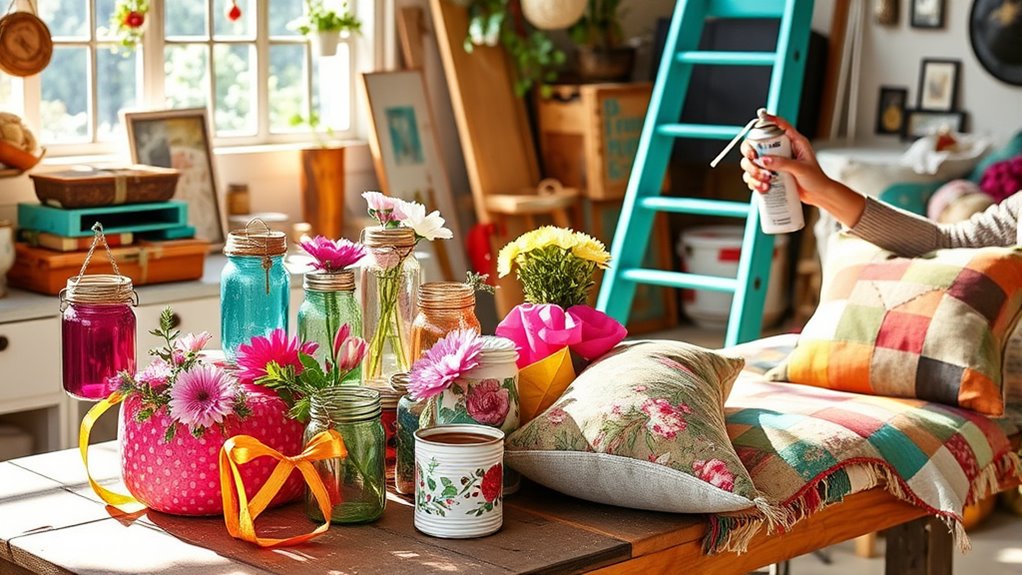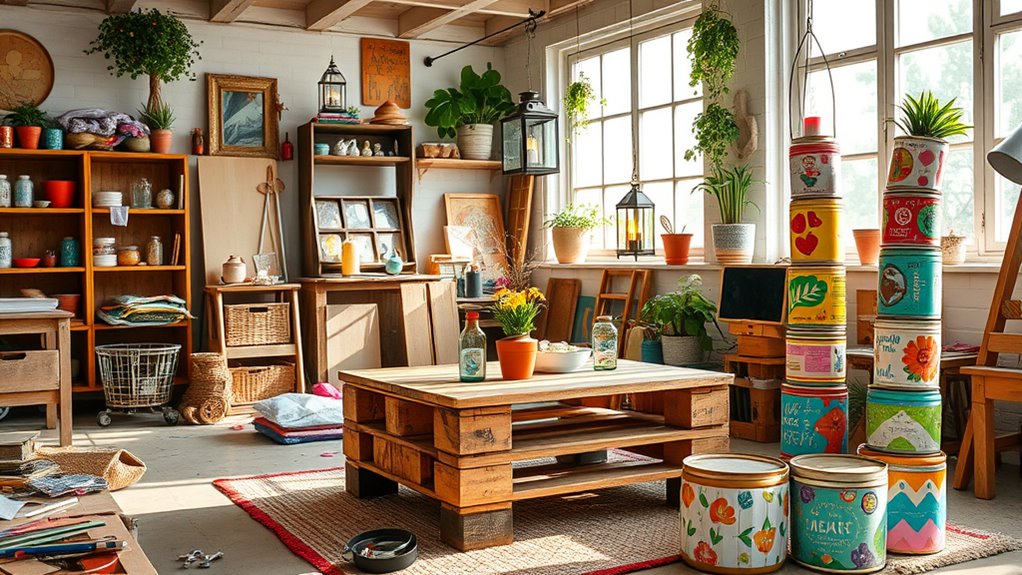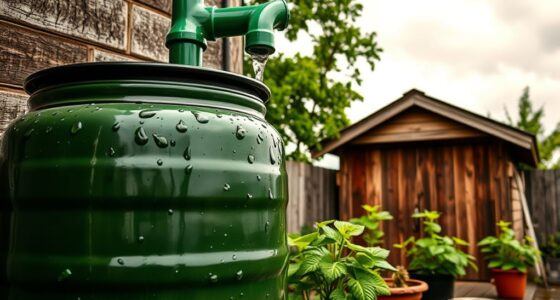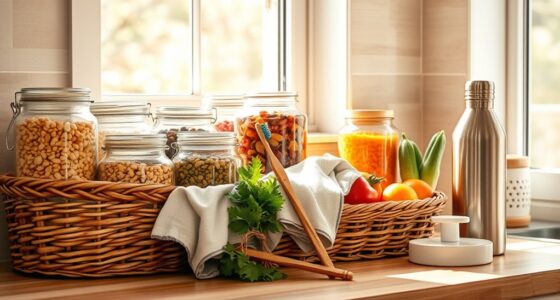To turn trash into treasures, start by identifying common household items like jars, furniture, fabric, and pallets that can be repurposed. Use eco-friendly paints, reclaimed materials, and simple techniques like sanding, decoupage, or repainting to transform these objects into stylish, functional pieces. This not only reduces waste but also promotes a sustainable lifestyle. Keep exploring creative ideas and smart tips to master upcycling and create gorgeous eco-conscious treasures beyond your expectations.
Key Takeaways
- Repurpose old jars as stylish storage solutions or planters with simple paint and decoration techniques.
- Transform worn-out furniture by sanding, repainting, or refinishing it for a fresh, eco-friendly makeover.
- Use unused fabric to create cushion covers, tote bags, or decorative accents, maximizing fabric’s potential.
- Convert wooden pallets into functional furniture like coffee tables or shelving units with minimal tools.
- Incorporate natural and reclaimed materials, such as hardware or paint, to enhance upcycled projects sustainably.

Have you ever wondered how to turn old items into something useful and stylish? Upcycling is a fantastic way to give your clutter a fresh purpose while helping the environment. The key lies in understanding simple recycling techniques that transform what might seem like junk into unique, eco-friendly treasures. By using eco friendly materials and your creative skills, you can craft items that not only look great but also reduce waste.
Start by evaluating what you already have at home. Old jars, worn-out furniture, or unused fabric can all be repurposed with a few clever recycling techniques. For example, glass jars can become chic storage containers or planters with some paint and decorative touches. Wooden pallets, often discarded, can be turned into coffee tables or shelving units. The trick is to think beyond their original purpose and see their potential for something new. When you’re working with these materials, opt for eco friendly options—like natural paints, non-toxic adhesives, or biodegradable sealants—to keep your projects environmentally responsible.
Repurpose jars, furniture, and fabric with eco-friendly paints and adhesives for stylish, sustainable projects.
Using eco friendly materials is especially important because it ensures your upcycled creations are sustainable from start to finish. Instead of buying new supplies, look for reclaimed or recycled materials that match your vision. For instance, old textiles can be transformed into cushion covers or tote bags, reducing waste and avoiding the need for new fabric. When you choose eco conscious options, you’re not just upcycling your items; you’re also reducing your carbon footprint and promoting a circular economy. This approach makes your projects more meaningful and aligns with eco-friendly living.
Additionally, understanding the importance of reliance on cloud services underscores how vital sustainable practices are in all areas of life, including upcycling, as it encourages us to seek eco friendly solutions whenever possible. As you develop your skills, experiment with different techniques. Sanding and repainting furniture can give it a fresh look, while decoupage can add artistic flair to tired surfaces. Don’t forget to incorporate natural elements or reclaimed hardware to enhance the sustainability of your projects. These small choices add up, turning simple upcycling into a lifestyle that champions eco consciousness. Plus, you’ll enjoy the satisfaction of creating something with your own hands that’s both functional and stylish.
In the end, the secret to successful upcycling lies in your willingness to see potential in everyday items and your dedication to using eco friendly materials. Each piece you transform reduces waste and demonstrates that sustainable living can be both practical and fashionable. With a little effort and creativity, you’ll find that turning trash into treasures isn’t just a catchphrase—it’s a rewarding way to decorate, organize, or gift while caring for the planet.
Frequently Asked Questions
What Are the Safest Materials to Upcycle at Home?
When considering the safest materials to upcycle at home, focus on items with clear recycling symbols, indicating they’re non-hazardous. Avoid materials with hazardous substances, like certain plastics or treated woods. Stick to glass jars, metal cans, and untreated wood, which are safe and easy to repurpose. Always check recycling symbols and labels to guarantee you’re not working with hazardous materials that could pose health risks during your upcycling projects.
How Do I Start an Upcycling Project With Limited Skills?
Starting an upcycling project with limited skills is easier than you think. Ignore recycling myths that suggest you need advanced skills; instead, focus on simple ideas for creative inspiration. Begin with small, manageable projects like transforming jars into planters or old furniture with a fresh coat of paint. Follow tutorials online, gather basic tools, and take your time. You’ll gain confidence, and soon, your trash will turn into treasures!
Are There Eco-Friendly Paints or Finishes Suitable for Upcycling?
Imagine transforming your project with a secret weapon—eco-friendly paints and natural finishes. These sustainable options are perfect when you want to upcycle responsibly without sacrificing style. You’ll find a variety of eco friendly paints that provide vibrant color and durability, while natural finishes enhance the beauty without harmful chemicals. Using them, you turn trash into treasures, knowing your creative efforts are kind to the planet. Ready to make your upcycling truly eco-conscious?
How Can I Price Upcycled Items for Resale?
You should start by researching similar upcycled items to understand market trends. Use pricing strategies like cost-plus pricing, factoring in your materials and time, and consider the resale value based on uniqueness and craftsmanship. Be flexible and test prices to see what customers are willing to pay. Remember, highlighting your item’s story can boost perceived value, helping you set fair prices that attract buyers while ensuring you profit.
What Tools Are Essential for Beginner Upcycling Projects?
When starting with upcycling art ideas and creative storage solutions, you’ll need basic tools like scissors, a hot glue gun, and sandpaper. A paintbrush and some paint or stain help add finishing touches. Don’t forget a ruler or measuring tape for precise cuts. These essentials make it easy to transform old items into unique pieces, giving your projects a professional look while keeping the process simple and fun.
Conclusion
Now that you know these upcycling hacks, you can transform everyday trash into beautiful treasures. Did you know that upcycling reduces waste by up to 70% compared to recycling? Not only will you save money, but you’ll also help the environment. So, keep experimenting with creative ideas, and remember—your trash has the potential to become something amazing. Start small, stay inspired, and enjoy turning your waste into wonderful, functional pieces!










